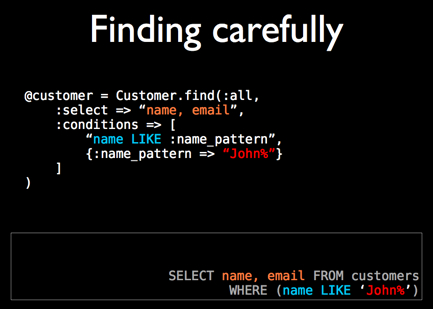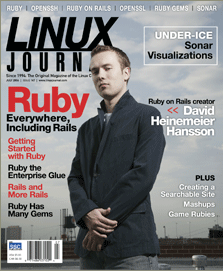RailsTidy is a plugin for Rails, by Damien Merenne, which validates your RHTML templates, the HTML output from your functional tests, and tidies up the HTML generated by Rails. Read More
It’s a few months old, but this guide to creating your own role based authentication system in Rails is pretty good. It doesn’t use any plugins other than the LoginGenerator. Read More
Craig Webster has posted several times over the few days about his adventures with sockets in Ruby. He provides nice code examples (even doing socket stuff direct from irb!) and his explanations are useful if you know what you’re doing with Ruby, but haven’t tried doing any TCP or socket work yet:
- Absolute basics: Connecting to ports – First, Craig looks at how easy it is to connect to a remote port and how to check if a port is open.
- Concurrent socket programming – Craig moves on to using Ruby threads to connect to multiple ports at the same time, building a very basic port scanner.
When using Rails it’s easy to forget there’s any other way. Sometimes, however, it’s useful to access databases outside of that environment. Luckily, ActiveRecord can be used separately from Rails, and Craig Webster demonstrates how. Read More
Devin Steffler shows you how to load over 100000 countries, states, and towns into your Rails app’s database, from how to get the data to the code to transform the data into database entries. Read More
Step 1: Get the Yahoo-Ruby API. It’s only a small Ruby file. Its only dependencies are net/http and REXML that come with Ruby anyway.
Step 2: Make sure you have a Yahoo! API ID. If you don’t, get one now.
Step 3: Use a script like this one from O’Reilly’s Yahoo! Hacks book. The code can be as simple as this: Read More
obj = WebSearch.new(‘insert app ID’, ‘chunky bacon’, ‘phrase’, 10)
results = obj.parse_results
# results now contains an array of hashes
puts results.inspect
Stuart Halloway and Justin Gehtland of Relevance LLC have put together an online presentation called AJAX on Rails. It looks at AJAX, its relation to Rails, how Prototype works, and provides lots of great code examples. If you want to brush up on your whole AJAX and Rails knowledge, it’s worth looking at. A PDF version is also available. Read More
An oldie but a goldie.. Kent Siblev had an issue with his Rails application ballooning to 150 megabytes of memory usage per process. He couldn’t figure out where the problem was, so he wrote a small plugin called MemoryLogging to check memory usage on each request (Linux only, I’m afraid). He found his problem within minutes and explains what was going on. Read More
The creator of co.mments, Assaf Arkin, a Rails developer, has created a plugin that makes it easy to add a Undo feature to your Rails app. Instead of warning users about things simply let them do it, but give them the choice to undo afterwards. Assaf’s plugin doesn’t cover all the bases, but it’s easy to build upon for creating your own system. For deletion, for example, you’d want to come up with a way to keep the data floating around for a while. Read More
Basic Ruby
- Detect if you’re running on Windows – Adds a method to Kernel called is_windows?
- Random Alphanumeric String Generator – Produces a random string of a chosen length using A-Za-z0-9.
- Full intersection between 2 arrays – Like ‘&’ but doesn’t remove duplicates in the original array.
- Call .sort with a block – Basic Ruby, but contains an extended section with an optimization and a to_proc version.
- Date.distance_to method – Gives you the distance between two dates in years, months, and days
- Match identical strings on the same line – Clever regex
- Quickly match first instance of a regex match
- Return ‘x’ random elements from an array – Extends the Array class with ‘randomly_pick’
Advanced Ruby
- Non-persistent ActiveRecord – Lets you create AR models without a corresponding database table
- Ruby Object Creation Tracer – Tells you where your objects are being created in your program
- Basic OpenGL Ruby example – An interesting place to start if you want to get into graphics / OpenGL.
This is a “short” Ruby on Rails reference. It’s goal is to give you an overview over the most used functions / methods / classes. It’s not a tutorial, but as a handy guide when you already know your way around.
The “InVisible Ruby on Rails Reference” is an excellent resource for all Rails developers. It covers models, controllers, views, HTML helpers, ActionMailer, session configuration, etc.. and it’s like the most ultimate, largest ‘cheat sheet’ for Rails. Lots of examples, lists, and references, all organized really well. This is a keeper.
UPDATE, June 6th! This Rails cheat sheet is also pretty good. Read More

Sebastian Delmont has put together a great PDF presentation covering most of the different ways to find things with ActiveRecord in Rails. Excellent. Read More
Tar2RubyScript is a tool that packages up your entire Rails application into a single tar file with a special loader so that users can get up and running with one click.
The next step is working out how to package up an entire Rails app, database, and WEBrick (or Mongrel) daemon into a single OS X .app folder so that you can distribute cool Web apps to run on people’s local machines. Snippets would be a great candidate for this. I’ll post more information when I figure it out! Read More

In this photo, a Ruby script has found the license plate and marked it with a red box (source below).
Camellia is a powerful ‘computer vision’ library you can use from Ruby. It’s written in C, is cross platform, and offers lots of features like color conversion, warping, filtering, drawing, and labeling. Here’s the source code to find the license plate in the photo above:
require ‘rubygems’
require_gem ‘camellia’
include Camellia
image=CamImage.new
# load picture alfa156.bmp
image.load_bmp(“resources/alfa156.bmp”)
yuv=image.to_yuv
# consider only the V plane (red)
yuv.set_roi(CamROI.new(3,0,0,yuv.width,yuv.height))
# threshold and encode
thr=yuv.encode_threshold(150)
# labeling
blobs=thr.labeling!
puts “#{blobs.nb_blobs} blobs detected”
# draw rectangle on all detected blobs
blobs.each {|b| image.draw_rectangle(b.left,b.top,b.left+b.width-1,b.top+b.height-1,cam_rgb(255,0,0))}
# save the resulting picture
image.save_bmp(“output/ruby_alfa156_labeling.bmp”)
# find out the biggest blob
sorted=blobs.sort {|a,b| b.surface<=>a.surface}
puts “The bigger blob is at position (#{sorted[0].cx},#{sorted[0].cy}) and its surface is #{sorted[0].surface}”
Update – May 2007: Paul Battley has worked out how to get this all running on Mac OS X. Read More

The creator of Ruby on Rails, David Heinemeier Hansson, has made the cover of Linux Journal. Of more interest is their impressive dedication to Ruby topics this month, another sure sign that Ruby is on the way up.
The nay-sayers have dismissed Ruby in the past, but if it isn’t higher than Python on the TIOBE Programming Community Index (popularity of different programming languages) by May 2008, I’ll eat my hat. Ruby is currently at #20 and Python is at #8. Read More
